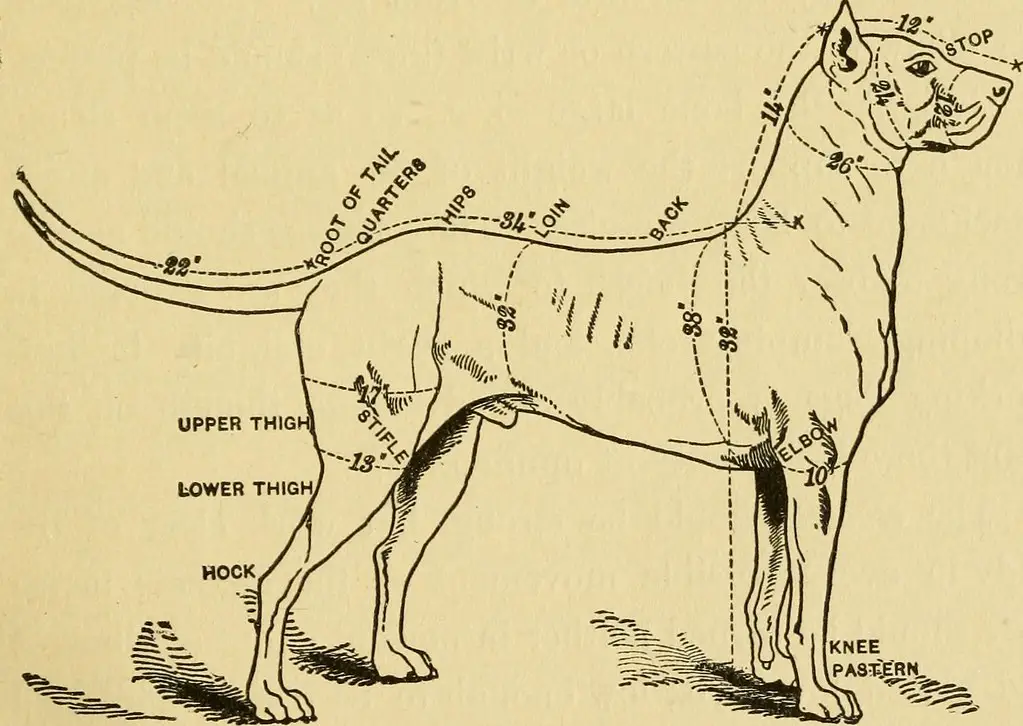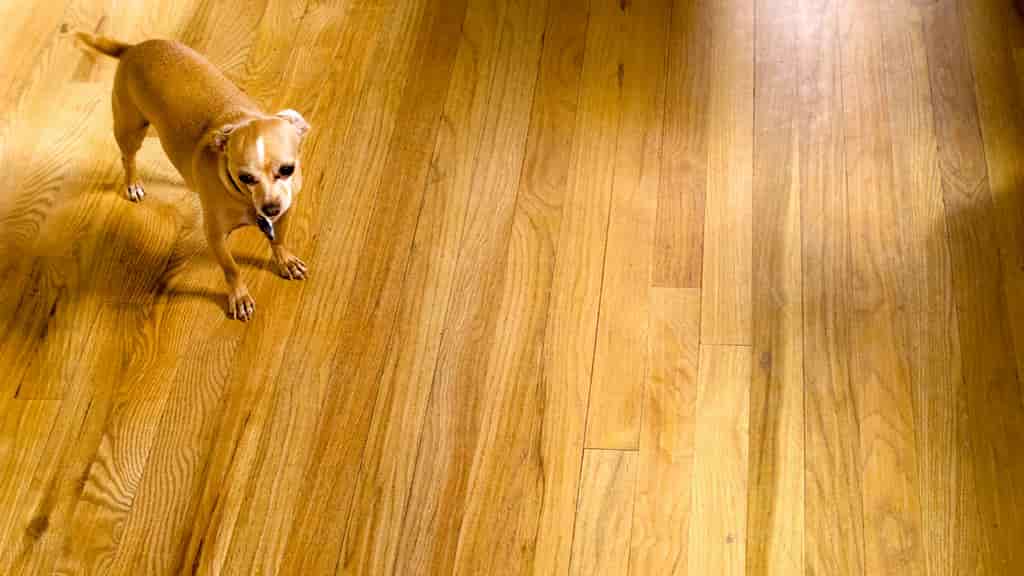When it comes to flooring for your home, there are a lot of different options to choose from. You can go with carpet, tile, or hardwood floors. While each of these options has its own benefits, some people wonder if hardwood floors are bad for dogs.
Dogs are a popular pet in the USA, According to research, almost 50% of American households own a dog!
Check U.S. pet ownership statistics.
Hardwood floors are growing in popularity due to their durability, aesthetic appeal, and easy maintenance. However, the rise in hardwood floor installation has also raised concerns about its impact on dogs’ hips. Dogs spend most of their time on the floor and as responsible pet owners, we must ensure that our furry friends are comfortable and safe at all times.
Importance of Dog Hip Health
Maintaining good hip health in dogs is crucial. It ensures that they can lead active, happy lives. Hips are a critical component of a dog’s skeletal structure, playing a huge role in their ability to run, jump, and even walk.
Degenerative conditions such as hip dysplasia can severely affect a dog’s quality of life, leading to pain, decreased activity levels, and in severe cases, lameness.
Ensuring that we provide environments conducive to good hip health, such as appropriate flooring, can help prevent these issues and keep our four-legged friends healthy and lively.
Understanding Dog’s Hip Structure
Anatomy of a Dog’s Hip

A dog’s hip is a ball-and-socket joint, composed mainly of the femur (the long bone extending from the hip to the knee) and the pelvic bone. The ball, or the femoral head, at the top end of the femur fits snugly into the acetabulum, a socket in the pelvis.
This arrangement allows for a wide range of motion while also providing stability. The surfaces of the femoral head and the acetabulum are covered with a smooth, slippery layer of cartilage that helps reduce friction and absorb shock during movement.
Ligaments, tendons, and muscles around the joint provide added support and control motion. An understanding of this intricate structure is crucial when considering the impact of flooring on the hip health of our canine companions.
Common Hip Problems in Dogs
Dogs, particularly certain breeds, are prone to hip-related health issues. The most common hip disorders include hip dysplasia, osteoarthritis, and hip dislocation.
Hip Dysplasia
Hip dysplasia is a genetic disorder most prevalent in large-breed dogs. This condition involves an improperly formed hip joint, where the ball and socket do not fit together correctly. This misalignment can lead to painful wear and tear as the dog ages.
Osteoarthritis
Osteoarthritis, or degenerative joint disease, often occurs secondary to hip dysplasia. It’s a progressive, degenerative condition where the cartilage that cushions the joints wears away, leading to pain and decreased mobility.
Hip Dislocation
Hip dislocation, or hip luxation, occurs when the femoral head is dislocated from the acetabulum. This can be due to a traumatic event or as a result of severe hip dysplasia. Immediate veterinary intervention is required in such cases.
The Impact of Hardwood Floors
Hardwood floors, while aesthetically pleasing and easy to clean, can pose potential threats to a dog’s hip health. These smooth, often slippery surfaces might cause dogs, especially those with existing hip problems, to struggle with maintaining traction.
This strain can exacerbate hip conditions such as dysplasia and osteoarthritis as the dog may overcompensate with abnormal movements to avoid slipping.
Over time, these unnatural compensations may cause undue stress on the hip joints, worsening their condition. Additionally, falls caused by slipping on hardwood floors can lead to traumatic hip dislocation.
Therefore, it’s important for dog owners to be mindful of these risks and take preventative measures to ensure their pet’s safety and well-being.
Scientific Views and Research Findings
Several scientific studies corroborate these concerns about hardwood floors and canine hip health. A study published in the journal “Veterinary and Comparative Orthopaedics and Traumatology” found a significant association between living in a home with hardwood floors and the development of hip dysplasia in dogs.
It suggested that lack of traction on such surfaces could potentially accelerate the degenerative process.
Similarly, a study in the “Journal of Small Animal Practice” noted that dogs recovering from hip dislocation surgery showed a higher rate of post-operative complications when housed in homes with slippery floors.
These complications included prolonged recovery times and increased risk of re-dislocation due to the instability and strain caused by the slick flooring.
These findings underscore the importance of considering our pets’ living environment in relation to their health. While we may appreciate the aesthetics and cleanliness of hardwood floors, it’s crucial to remember their potential hazards and make necessary adjustments to ensure our pets’ well-being.
Pros and Cons of Hardwood Floors for Dogs
Hardwood floors offer a range of benefits for dog owners, despite the concerns regarding canine hip health. First and foremost, they are hygienic and easy to clean.
Unlike carpets, hardwood floors do not trap dust, dirt, or pet dander, making them especially beneficial for households with allergy sufferers.
Moreover, for those inevitable pet accidents, hardwood floors offer easy cleanup without the worry of lingering smells or stains that you may encounter with carpeting.
In addition to hygiene, hardwood floors are remarkably durable and can withstand the wear and tear of energetic pets over time. While scratches can occur, these can be remedied with a bit of sanding and refinishing, thereby maintaining the longevity and beauty of the flooring.
Lastly, hardwood floors add a touch of elegance and sophistication to any home decor, a factor that can not be neglected. It’s important to note that while hardwood floors do present some potential risks for dogs, with careful management and preventive measures, they can still be a viable option for pet-friendly households.
However, hardwood floors also come with certain disadvantages, particularly concerning the well-being of dogs’ hips. The slick surface of hardwood floors can pose a serious risk for dogs, especially for breeds prone to hip dysplasia or other joint-related problems.
The lack of traction on these surfaces can lead to slipping and sliding, which over time may result in strain and damage to the hip joint. This can be particularly hazardous for puppies whose joints are still developing and for senior dogs who may already suffer from joint pain or arthritis.
Moreover, dogs with already existing hip conditions may experience increased discomfort and exacerbation of their condition due to the hard and unforgiving nature of the flooring.
Dogs need surfaces that provide some level of give to cushion their joints while moving around, a quality that hardwood floors simply do not provide.
Alternative Flooring Options
For those who want to create a more pet-friendly environment, there are several alternative flooring options available.
Vinyl flooring is a popular choice for pet owners due to its durability, stain resistance, and ability to provide some level of cushioning for your pet’s joints. It is also easy to clean and relatively affordable.
Cork flooring is another excellent choice. It’s hypoallergenic, antimicrobial, and has a natural springiness, providing comfort for your pet’s joints. Additionally, its sound-dampening quality can be beneficial for dogs with sensitive hearing.
A third option is bamboo flooring. This is hard-wearing, stain-resistant, and made from a highly renewable source, making it a great eco-friendly choice.
Lastly, pet owners could also consider carpet tiles. These are easier to replace if a section becomes damaged or stained, and they provide a soft, warm surface for your pet to rest on.
Comparing these alternative flooring options to hardwood flooring with respect to dogs’ hip health presents a clear distinction.
The hardness of hardwood flooring can potentially exacerbate existing joint issues in dogs and contribute to new problems. In contrast, vinyl flooring, with its certain degree of cushioning, can help relieve pressure on a dog’s joints. Cork flooring, with its natural springiness, is even more beneficial for dogs’ hip health, providing a comfortable surface for movement.
Bamboo flooring, although hard-wearing, is typically softer than hardwood, and thus friendlier to a dog’s joints. Carpet tiles, with their soft and warm nature, are perhaps the kindest to dogs’ hips.
It’s essential to note that all these alternatives also offer varying degrees of durability, ease of cleaning, and aesthetic appeal, but their superior performance in terms of dogs’ hip health makes them a more responsible choice for pet owners.
Tips to Mitigate the Impact of Hardwood Floors on Dogs’ Hips
Preventive Measures
Implementing preventive measures can significantly reduce the negative impact of hardwood floors on dogs’ hips. One practical step is to add area rugs or mats on the hardwood flooring, particularly in areas where your dog frequently moves or plays. These provide traction and cushioning, reducing the strain on your dog’s joints.
Another method is to regularly trim your pet’s nails. Overgrown nails can make your dog slip on the sleek surface, leading to unnecessary pressure on their hips. It’s also beneficial to maintain your pet’s optimal weight.
Excessive weight can lead to greater stress on your dog’s hips and exacerbate any joint issues. Lastly, regular gentle exercise can help keep your dog’s joints flexible and strong. It’s important to consult with your vet for an exercise regimen suitable for your pet’s age, breed, and health condition.
These preventive measures, in conjunction with an appropriate flooring choice, can create a comfortable and safe environment for your dog.
Modifying the Environment
Modifying your dog’s environment can also significantly alleviate the impact of hardwood floors on their hips.
Dog ramps or stairs can be particularly beneficial for dogs with hip issues. These items allow your pet to access higher areas, such as beds or couches, without needing to jump and unnecessarily strain their joints.
Non-slip socks or booties for your dog can provide additional traction and prevent slipping on hardwood floors, which often leads to hip stress. It’s also beneficial to consider orthopedic dog beds.
These beds offer enhanced support for your dog’s joints and can aid in mitigating the negative effects of hardwood floors on their hip health. In colder months, consider providing a warm bed or blanket for your dog, as cold weather can often stiffen joints and exacerbate hip issues.
Remember, regular check-ups with your vet are vital as well, to ensure that your modifications and preventive measures are effectively supporting your dog’s hip health.
Conclusion
In conclusion, hardwood floors can indeed pose potential challenges to a dog’s hip health, but with the right preventative measures and environmental modifications, their impact can be significantly reduced.
It’s about creating balance – maintaining a healthy weight, providing regular, gentle exercise, and making modifications in their environment can all contribute to the wellness of your furry friend.
Non-slip socks, ramps, orthopedic beds, and keeping your pet warm during cold months are all effective approaches. Ongoing vet check-ups are vital to ensure your dog’s hip health remains optimal.
Remember, each dog is unique, and what works best for one may not necessarily be ideal for another. As a responsible pet owner, it’s crucial to stay proactive and always consider your pet’s comfort and well-being at the forefront.
FAQ
Is vinyl plank flooring dog-friendly?
As we know, vinyl flooring is much more durable, waterproof, stain-resistant, and most importantly scratch-resistant. So, it would be a dog-friendly flooring that allows a dog to move freely anywhere in a home. Moreover, vinyl flooring is suitable for other pets like cats as well.
What flooring is not slippery for dogs?
Whenever a floor gets wet, it will be slippery for dogs and other pets. To keep a dog safe you have to take care of the moisture level on your floor regularly. However, vinyl, carpet, tile, and hardwood floorings are considered safer for dogs with proper care.


1 thought on “Are Hardwood Floors Bad For Dogs Hips? (Guide)”